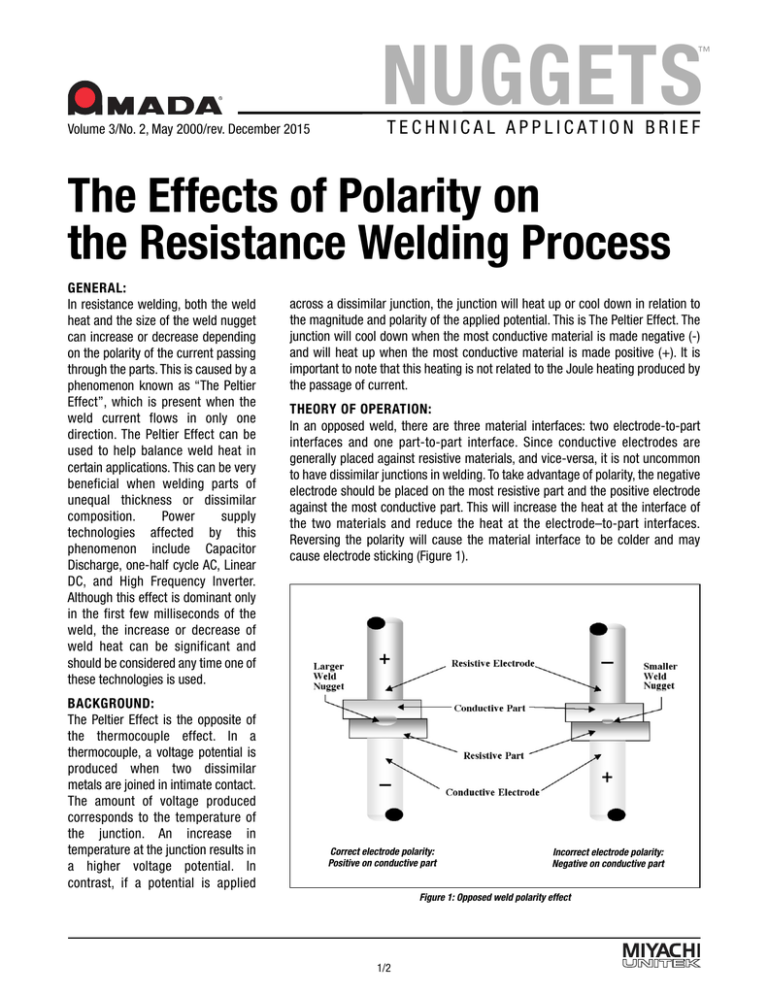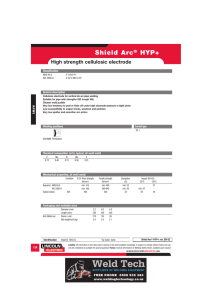
NUGGETS
™
Volume 3/No. 2, May 2000/rev. December 2015
T E C H N I C A L A P P L I C AT I O N B R I E F
The Effects of Polarity on
the Resistance Welding Process
GENERAL:
In resistance welding, both the weld
heat and the size of the weld nugget
can increase or decrease depending
on the polarity of the current passing
through the parts. This is caused by a
phenomenon known as “The Peltier
Effect”, which is present when the
weld current flows in only one
direction. The Peltier Effect can be
used to help balance weld heat in
certain applications. This can be very
beneficial when welding parts of
unequal thickness or dissimilar
composition.
Power
supply
technologies affected by this
phenomenon include Capacitor
Discharge, one-half cycle AC, Linear
DC, and High Frequency Inverter.
Although this effect is dominant only
in the first few milliseconds of the
weld, the increase or decrease of
weld heat can be significant and
should be considered any time one of
these technologies is used.
BACKGROUND:
The Peltier Effect is the opposite of
the thermocouple effect. In a
thermocouple, a voltage potential is
produced when two dissimilar
metals are joined in intimate contact.
The amount of voltage produced
corresponds to the temperature of
the junction. An increase in
temperature at the junction results in
a higher voltage potential. In
contrast, if a potential is applied
across a dissimilar junction, the junction will heat up or cool down in relation to
the magnitude and polarity of the applied potential. This is The Peltier Effect. The
junction will cool down when the most conductive material is made negative (-)
and will heat up when the most conductive material is made positive (+). It is
important to note that this heating is not related to the Joule heating produced by
the passage of current.
THEORY OF OPERATION:
In an opposed weld, there are three material interfaces: two electrode-to-part
interfaces and one part-to-part interface. Since conductive electrodes are
generally placed against resistive materials, and vice-versa, it is not uncommon
to have dissimilar junctions in welding. To take advantage of polarity, the negative
electrode should be placed on the most resistive part and the positive electrode
against the most conductive part. This will increase the heat at the interface of
the two materials and reduce the heat at the electrode–to-part interfaces.
Reversing the polarity will cause the material interface to be colder and may
cause electrode sticking (Figure 1).
Correct electrode polarity:
Positive on conductive part
Incorrect electrode polarity:
Negative on conductive part
Figure 1: Opposed weld polarity effect
1/2
NUGGETS
™
T E C H N I C A L A P P L I C AT I O N B R I E F
Place negative electrode
against the thinner piece to help
balance the weld nugget
When welding two resistive parts with
conductive electrodes, The Peltier
Effect will cause the weld nugget to
be drawn towards the positive
electrode-to-part interface. If the parts
are of unequal thickness, The Peltier
Effect can be utilized to help balance
the nugget. The negative electrode
should be placed against the thinner
piece (Figure 2). Alternately, when
welding two conductive parts with
resistive electrodes, the negative
electrode should be placed against
the thicker piece.
Figure 2: Welding resistive parts of unequal
thickness
In series welding, where both
electrodes are in contact with the top
part, The Peltier Effect can cause one
weld nugget to be larger than the
other. Figure 3 depicts the typical
series electrode configuration used
for welding Nickel plated steel or
Nickel 200 connecting tabs to cold
rolled steel battery caps.
Decrease force on negative
electrode or increase force on
positive electrode to balance
size of the weld nuggets
Larger
Weld
Nugget
In this example, the tab material is
common to both electrodes, but The
Peltier Effect still exists because the
current flows through the low
resistance electrodes and high
Negative electrode will have
smaller weld nugget
resistance tab material. Assuming
equal electrode forces and electrode
diameters, the weld nugget under the
positive electrode is typically larger.
Adjusting the weld force on each
electrode can normally compensate
for the difference in weld nugget size.
Referring to Figure 3, reduce the force
on the negative electrode or increase
the force on the positive electrode to
balance the nugget size.
SUMMARY:
In resistance welding, the effects of
polarity should be evaluated
whenever the weld current flows in a
single direction. The Peltier Effect,
which is opposite to the thermocouple
effect, can be used to help balance
the weld nugget in certain
applications. It can be especially
useful when the parts to be welded
are not the same thickness. In series
welding applications, polarity can
cause the size of the weld nuggets to
be unequal. Adjusting electrode forces
can help to compensate for unequal
weld nugget growth.
Figure 3: Series welding of a battery tab to cell
1820 S. Myrtle Ave. • Monrovia, CA 91016 US
T: (626) 303-5676 • F: (626) 358-8048
info@amadamiyachi.com • www.amadamiyachi.com
ISO 9001 Certified Company • 24/7 Repair Service: 1-866-751-7378
Amada Miyachi
America Mexico
El Paso, TX 79925
T: (915) 881-8765
mxsales@amadamiyachi.com
Amada Miyachi do
Brasil Ltda.
Sao Paulo, Brasil
T: +55-11-4193-3607
antonio.ruiz@amadamiyachi.com
EUROPE
Amada Miyachi
Europe GmbH
Puchheim, Germany
T: +49 (0) 89 83 94 030
infode@amadamiyachi.eu
ASIA
Amada Miyachi Co., Ltd.
Noda, 278-0016 Japan
T: +81-4-7125-6177
sales@miyachi.com
Amada Miyachi
Shanghai, Co., Ltd.
Shanghai, China
T: +86-21-6448-6000
zqzhang@msc.miyachi.com
Amada Miyachi
Korea Co., Ltd.
Gyeonggi-do, Korea
T: +82-31-8015-6810
dykim@mkc.miyachi.com
Amada Miyachi
(Thailand) Co., Ltd.
Samutprakarn, Thailand
T: +66-2751-9337-8
info@mtl.miyachi.com
Amada Miyachi
Taiwan Co., Ltd.
Taipei, Taiwan R.O.C.
T: 886-2-2397-4778
keigaku@miyachi.com
Amada Miyachi
Vietnam Co., Ltd.
Ho Chi Minh City, Vietnam
T: +84-8-3771-7972
follow us on:
Specifications subject to change without notice. Copyright© 2015 Amada Miyachi America, Inc. The material contained herein cannot
be reproduced or used in any other way without the express written permission of Amada Miyachi America, Inc. All rights reserved.
2/2
Amada Miyachi
India Pvt., Ltd.
Bangalore, Karnataka
T: 080-4092-1749 & 3549
info@miyachiindia.com
991-472
AMERICAS
Amada Miyachi
America Midwest
Wixom, MI 48393
T: (248) 313-3078
midwestsales@amadamiyachi.com






